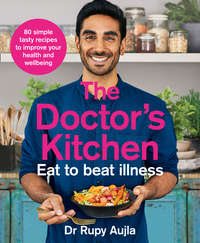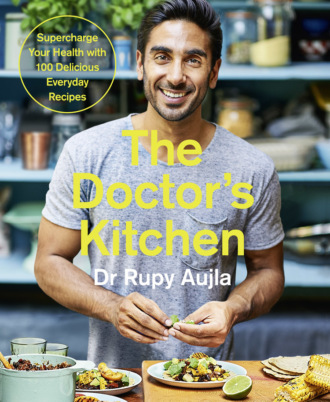
Полная версия
The Doctor’s Kitchen: Supercharge your health with 100 delicious everyday recipes
In general practice there is a clear need for medications, but where a cost-effective, evidence-based alternative exists and has a plausible mechanism of action I would encourage us as a scientific community to investigate and embrace it. I urge physicians and patients to explore the multitude of other treatment methods before we succumb to medications for chronic conditions. This needs to happen. Healthcare systems across the Western world are crumbling under the weight of growing financial demands10,11 and no matter how much we invest in novel therapeutics we must always start with simple diet and lifestyle measures. I am here to empower you.
Discovering the plethora of studies demonstrating how effective lifestyle interventions are was revolutionary to me. In fact, our current guidelines for some of the most common lifestyle-related diseases reflect this. The first step to tackling diabetes, hypertension and high cholesterol according to the National Institute for Health and Care Excellence is ‘Lifestyle Change’.12,13,14 Yet most doctors wouldn’t know where to start when it comes to giving dietary advice and this poor ability to motivate our patients to embrace a healthy outlook is reflected by how over-medicated we are as a population. I’m convinced that our indulgence in pills over plates is a product of poor nutrition training in the medical curricula, which still stands at less than 20 hours of teaching during a five-year medical degree.15,16 If medical students were encouraged to learn more about the impact of lifestyle, we’d have a much healthier nation.17,18 Our lack of knowledge, short consultation times and patient demand for a quick fix creates a scenario where the easiest option is to provide pharmaceuticals. But, the first thing we should be asking before reaching for that prescription pad is, ‘What are you eating?’
Our population is plagued by obesity, stress and cardiovascular disease, and the prevalence of these conditions is rising fast.19 The answer to our epidemic of chronic disease is staring at us from the grocery aisles. I want to prevent the need for invasive devices, powerful prescription medications or painful procedures and offer a delightful alternative: eating fresh produce, colourful plants and igniting a passion for flavour! Best of all, the creativity and pleasure of preparing and eating good food is attainable for everyone.
The answer to our epidemic of chronic disease is staring at us from the grocery aisles.
Rather than using this section to bombard you with myriad papers, details of trials and large studies to prove a point, I’ve speckled all the recipes with bite-sized chunks of information to give you a sense of this interesting research. I’ve also included amongst the recipes some further information on my favourite ingredients and their amazing health benefits (see here). You might expect ‘health food’ to be bland and lacking variety, but I’m going to show you it’s the exact opposite. Flavour as well as function is what I’m passionate about, and diversity of ingredients is essential. Our health depends on it.
Health is not a privilege

As a GP in the NHS, I’m passionate about accessible healthcare for everyone. I am fully aware that people’s circumstances are different and there is a perception that using fresh produce and eating well is expensive and attainable only for the privileged. It doesn’t have to be.
Well-branded supplements, yoga on top of luxury hotels and eye-wateringly expensive turmeric lattes … You’d be forgiven for thinking a ‘healthy’ life was akin to an exclusive, invite-only club. Most of my colleagues expect me to cynically dismiss this trend. After all, it’s damaging to people’s self-esteem, it promotes an unhealthy attitude towards body image and excludes those in society that are the most vulnerable. But, actually, I believe we need to think beyond a ‘them’ and ‘us’ attitude. Despite its many flaws and shortcomings, the wellness industry has done an unbelievable job of motivating a generation of millennials to drink green smoothies, include kale as a staple in their shopping baskets, and exercise. No number of doctor visits could create such impressive behavioural change!
Without the allure of healthy living promoted by aspirational figures, ‘food in medicine’ wouldn’t have gained such attention in recent years. So, while doctors and health professionals can be damning of the industry, I’m grateful for the spotlight and want to know, where we can steer this trend in the future?
My aim is to make healthy eating inclusive and accessible to all. I personally witness a sense of elitism around eating well and many of my patients associate health with wealth. I’m constantly challenged in the consulting room by patients who believe they don’t have the time or money for a good diet. I see patients from all walks of life and let me share this with you: just because you are well off doesn’t automatically make you healthy, even if you can afford expensive ingredients.
Forget all of your preconceptions of ‘wellness’.
The most nutritionally dense foods are the least expensive on the shelf. These are the real ‘superfoods’ available in supermarkets, and that’s why I focus on them. Once you understand the principles of eating well, health doesn’t become a privilege. It’s a choice no more expensive than the average household can afford.
The most nutritionally dense foods are the least expensive on the shelf.
I’m proud to work with a lottery-funded community kitchen, Made in Hackney, to dispel these myths. We inform people about where to get local organic produce, veg drop boxes and, ultimately, how to use wholesome ingredients in our daily life cheaply and efficiently. As the only doctor in the organisation, I lend a clinical perspective to the kitchen sessions. It’s humbling to have the opportunity to explore people’s experiences of food in medicine and break the cycle of ‘can’t cook, won’t cook’ attitudes.

Think of the repercussions for public health if everybody nationwide had access to simple nutritional advice and was taught the fundamentals of healthy living? Healthy eating is attainable whatever your background. This isn’t an exclusive club; it’s how we shape the future of wellness.
Why I eat ‘plant-focused’

On social media people often mistake me for a vegetarian or vegan because I get so excitable about vegetables. I do actually eat all types of meat and fish but I focus my diet around plants.
Rest assured there is logical reasoning underpinning my enthusiasm for chicory, cabbages and – of course – the greens! Abundant in vitamins and minerals, everybody generally knows they’re ‘good for us’, but the story goes a lot deeper.
Phytochemicals, the chemicals found in plants, are another explanation for the incredible health benefits of fruits and vegetables.20 These are what give plants their pigment, smell and, importantly, flavour.21 It’s the study of these chemicals that ignited my passion for nutritional medicine. A number of research papers look at their effect on inflammation,22 bone health23 and even cancer.24 We have only scratched the surface when it comes to investigating just how influential these thousands of bioactive compounds are to human health. But, looking at the associations between food and disease, the positive impact of diets largely based on plants and whole foods is indisputable.25 This is why they make up the bulk of my daily plate and why they should feature heavily on yours, too.
Eat mostly plants and you’ll stand a better chance at living a healthier, more vibrant and fulfilling life, free of disease.
These compounds exist in a multitude of produce that is commonplace in grocery stores nationwide. Everything from a simple carrot to your basic apple is brimming with phytochemicals like quercetin and carotene.26 These simple, affordable and accessible ingredients are key to good health. What’s more, eating plates of a variety of colourful plants is the easiest way to guarantee a complete range of these phytochemicals,27 which is why my dishes appear so vibrant. Using a multitude of herbs and spices (which have their own health benefits) to complement the ingredients is an easy undertaking for a home cook once you know how.
Having sifted through piles of studies involving thousands of people (followed up for years) and experiments examining the biological mechanisms behind the health-promoting effect of food, I can tell you the evidence is convincing. You can lower your risk of stroke, cancer and heart disease by increasing your fruit and vegetable intake.28,25,29,30 Eat mostly plants and you’ll stand a better chance at living a healthier, more vibrant and fulfilling life, free of disease.
I enjoy animal protein of all varieties – fish, poultry, chicken, game and beef – about once or twice a week. Animal products are an easy and delicious source of complete proteins. Key micronutrients such as zinc and vitamin B12 are nutritional qualities very hard to obtain in purely plant-based diets.31 But, I see meat and animal products as a luxury item in the same way our ancestors would have treated them.32,33
On the subject of meat, I do have concerns about the harmful effects of cheaper mass-produced livestock on our health and the environment. On balance, a stressed, improperly reared animal is not likely to be good for us despite the benefits of convenient protein and nutrients. The type of feed, use of medications and the space an animal has been allowed to roam in all have an impact on their health and can negatively impact ours.34
The most well-studied diet we have access to has examined the eating habits of thousands of patients over decades. That is the Mediterranean diet. I am unapologetic for it not being a new, sexy, alternative eating plan that will grab headlines. Instead, it’s solid, evidence-based nutritional advice about how the majority of us would benefit from eating.35 It’s a launch-pad to start a healthy lifestyle journey, I know it’s safe and … it’s actually quite vegetarian! It doesn’t mean piles of pasta, bread and quick-releasing carbohydrates. It focuses on plant-based sources of protein and fibre, such as nuts and legumes, good-quality fat and a limit on meat intake.36
Eating based on the principles of a Mediterranean diet is a good starting point, and is one I personally follow. For these science-grounded arguments, I think focusing meals around plants is a good, well-established entry point for most people.
Instead of pushing a particular dietary dogma I want to encourage you to choose a fitter lifestyle by tempting your taste buds rather than making you eat vegetables because you feel you ought to. This way of eating doesn’t have to be boring. I’m using the principles of this diet to create enticing multi-ethnic dishes that you can tweak according to your preferences. This journey is not limited in its culinary scope and I hope to show you why it’s also medicinal.

Plant-based protein
As I eat a largely plant-based diet I’m all too familiar with the question, ‘So where do you get your protein from?’ It’s imperative to bring attention to all the amazing sources of plant-based protein available to us. A more pressing public health concern is actually the lack of nutrient density in our diets, not to mention a lack of fibre. Fortunately, plants that are high in protein also have a large amount of fibre and a wealth of other health-promoting plant chemicals. I still enjoy meat and fish, but the majority of my protein comes from a selection of these wonderfully delicious plant sources. Here are some of my favourites.
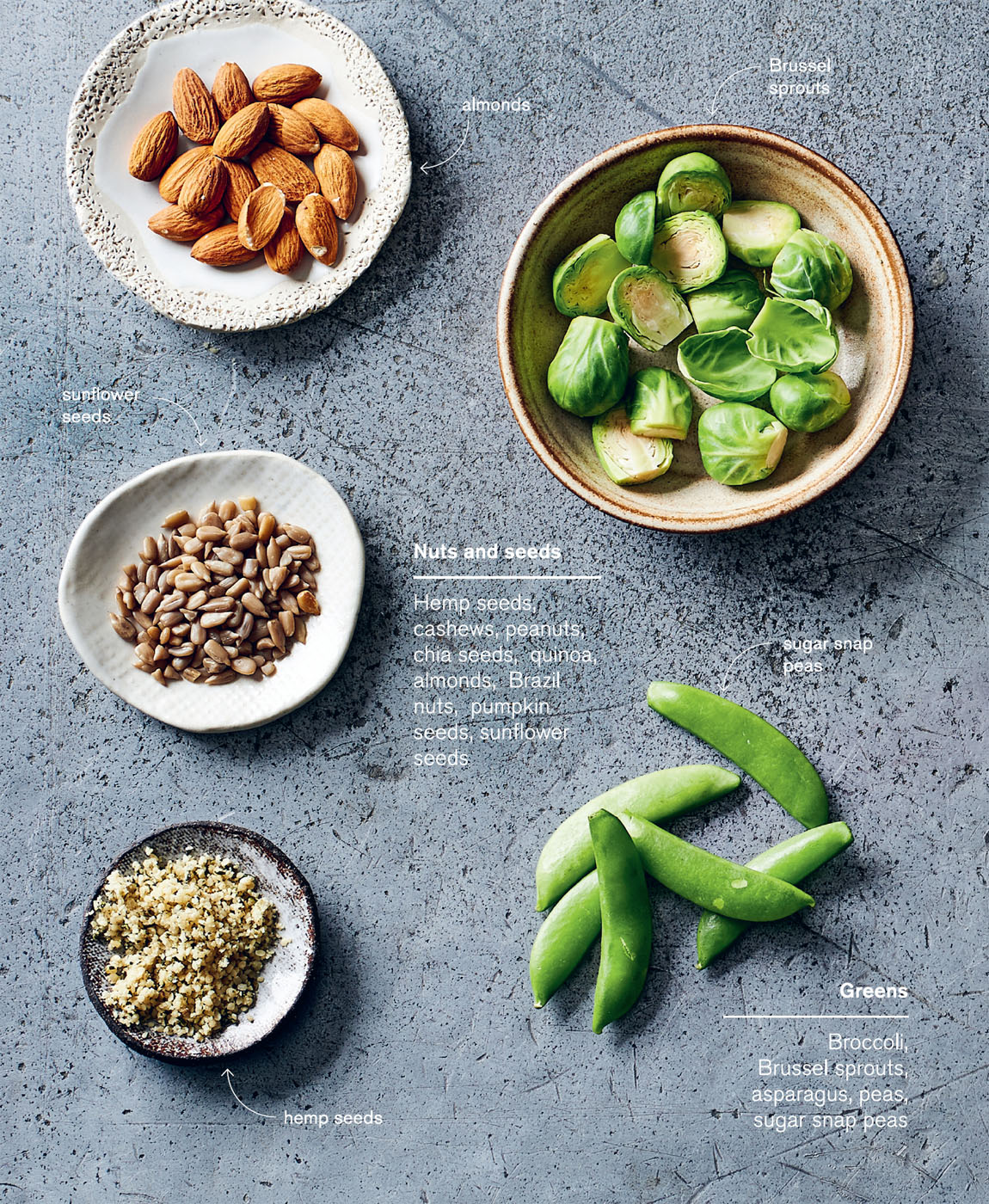
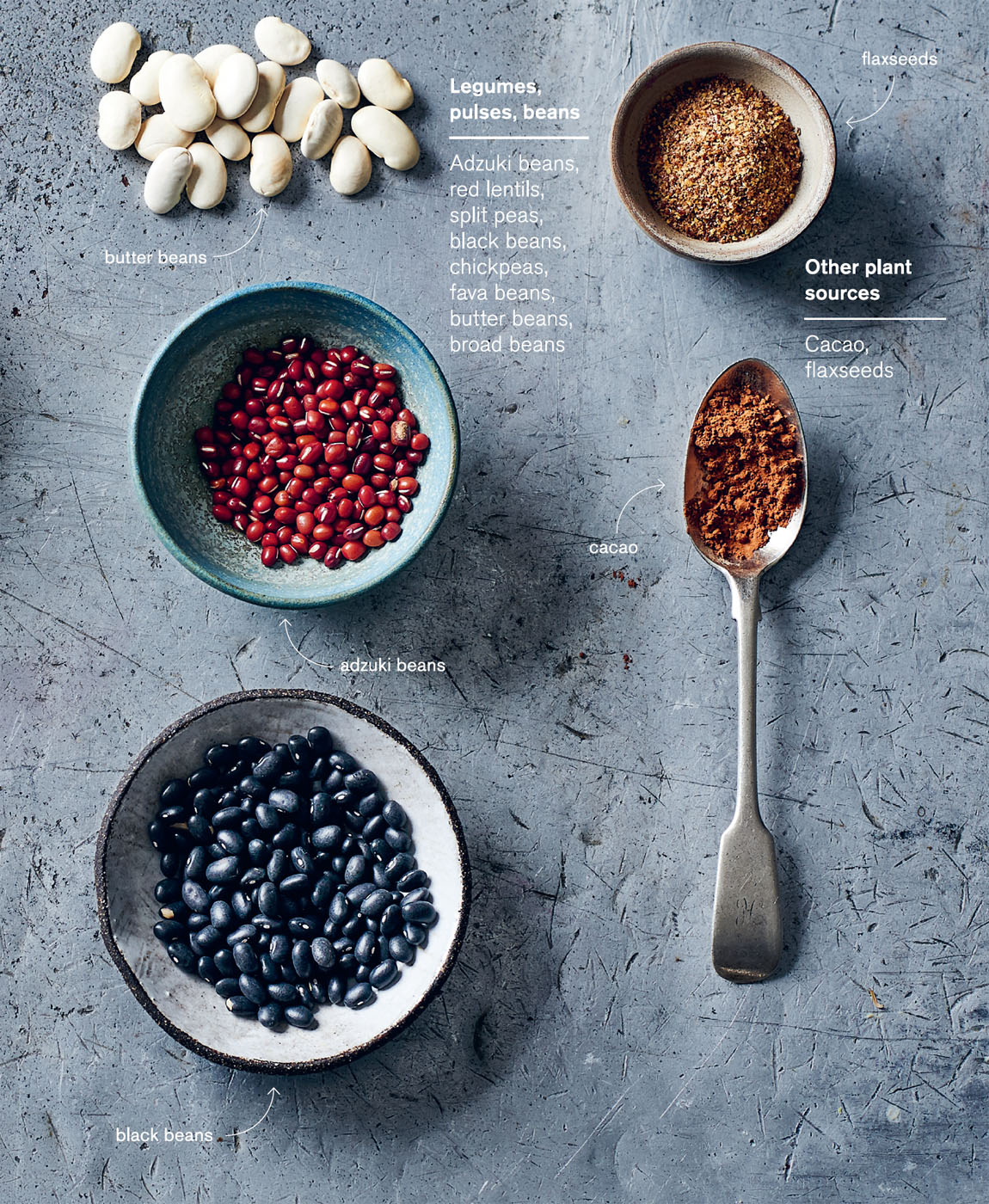
Health is in the gut of the beholder

I want to take you on a journey through recent scientific discoveries in nutrition that are shaping our knowledge of food in medicine. We could not start anywhere more exciting than with our digestive system.
Despite the exhausting and confusing gut-health messages in the media, the science behind our microbiome (the population of microbes that live in or around the body) is compelling. Studies looking at the microbiome have accelerated over the last decade and doctors are calling it ‘the forgotten organ’.37
The trillions of microbes (including fungi, bacteria and viruses) largely concentrated in our colon are thought to protect us from infections,38 break down molecules of food,39 create neurotransmitters and even alter our immune system.40,41 These microbes could impact diseases as far-ranging as dementia42 and diabetes.43 Neurologists, endocrinologists and psychiatrists are all looking at gut-focused treatments for a range of conditions we never thought were related. Even critical-care specialists who work in intensive care are getting involved in the conversation about how the gut impacts treatment of the sickest patients in hospital.44
The hype is real. Gut health is very important and the current discussion in medicine is going far beyond the expensive yoghurt drinks on supermarket shelves. Rather than a fad, I see the popularity of foods to help our microbiome as a return to traditional methods of eating that our ancestors developed. And there’s evidence for this across all cultural backgrounds. In Japan, pickled ginger is consumed with sushi and miso broth is prepared before large meals. Indians drink fermented yoghurt-based drinks (‘lassi’) and eat a range of pickles with curries. Middle Easterners enjoy kefir, Nordics have smörgåsgurka and Koreans love their kimchi. Spotting a trend? Fermented foods have a long, well-established history throughout different societies’ eating habits, but a lot has changed in Western diets.
Food just doesn’t have the same qualities it used to. We pasteurise, radiate and add a ton of additives to processed foods to make them sterile for convenience and shelf life. All of which have been shown to negatively impact the microbiome.45
This concept of bacteria being beneficial is alien to a lot of people because we’re taught to think of them as harmful. But the vast majority of bacteria that live in our body are performing vital functions that allow us to maintain our health. These bacteria are in constant communication with our own cells and it’s important we look after them. I want to encourage you to eat foods that protect and boost your microbiome while introducing bacteria back into your diet.
Eating a diet that nurtures our microbiome is what the current research lends itself toward, but that does not necessarily mean you need to consume expensive supplements and tinctures. Instead, here are some evidence-based and safe dietary interventions to improve your gut health … deliciously!
Eating a diet that nurtures our microbiome is what the current research lends itself toward, but that does not necessarily mean you need to consume expensive supplements and tinctures.
• Prebiotic foods are where the power is! These are specialised types of fibre that are indigestible by the human intestine, but our microbes are able to break them down. Prebiotic fibres essentially feed our microbes and keep them healthy. Not only are they cheap and accessible, they bring a wealth of different flavours and textures to a meal. Jerusalem artichokes, asparagus stem, flax, chicory, wholegrains and pulses are great examples of fibre-rich foods your bugs and taste buds will love, and this book is full of examples of how to get them into your diet. I make everything from stews, meatballs and roasts from these ingredients. This ‘health’ food is delicious and easy to incorporate into your way of eating. Plus, by generally increasing all types of fibre, we can potentially reduce the incidence of cancers, cardiovascular disease and inflammation of the bowel.46
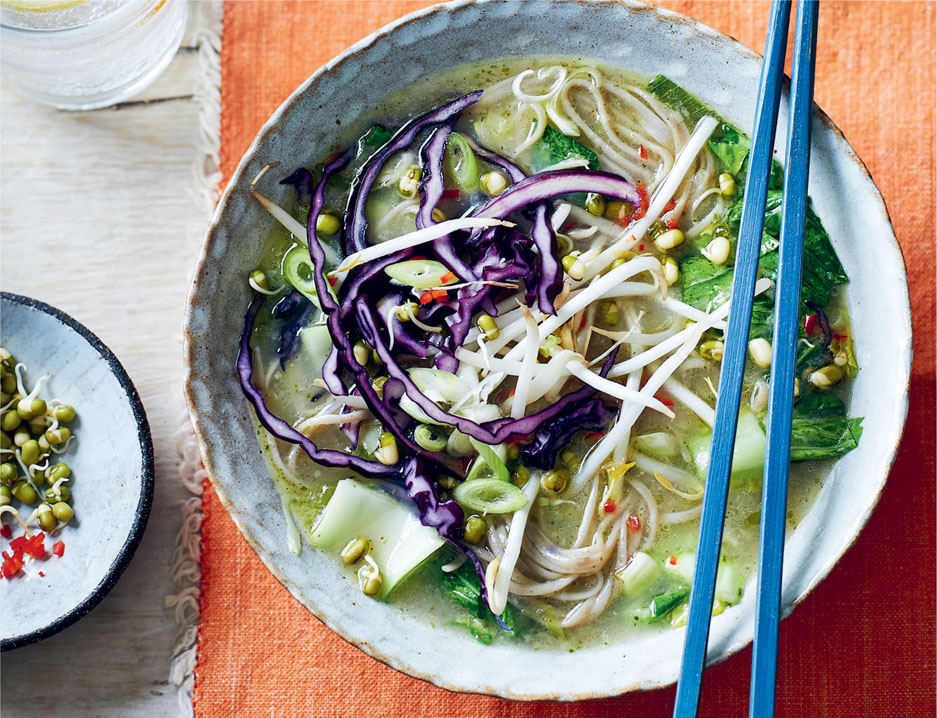
• Probiotic foods taste delicious and are a natural way of introducing live bacteria into your body. Despite the popularity of probiotic capsules and powders it’s important to remember that none of these products is created equal. It’s true that some research has shown benefits for urinary-tract disorders47 and irritable bowel,48 but the study of which bugs can potentially impact a condition is still very much in its infancy.49,50
For now, I encourage experimenting with different ingredients like traditionally prepared kimchi, sauerkrauts and probiotic yoghurts that are full of different strains of bacteria that may have benefits.51,52,53 Look for unpasteurised varieties usually found in the fridge section of supermarkets. Experiment by folding them through salads or simply adding them to the side of a dish as a garnish. They can complement the simplest of dishes and add another dimension of flavour.
I see the popularity of foods to help our microbiome as a return to traditional methods of eating …
• Polyphenol-rich foods like cacao, dark green leafy vegetables, beetroot and green tea are richly coloured and intensely flavoured ingredients that bring a host of benefits to your body.54 Polyphenols are chemicals we find in plants of which there are literally thousands. Some of them have been shown to improve the gut lining, encourage growth of microbe patterns that are beneficial as well as have other advantages to general health. My recipes are designed to incorporate as many different polyphenol-rich foods as possible.
• Spice your food. Turmeric, cumin, sumac, cinnamon and caraway are just some of the ingredients that improve the aroma and taste of foods, but spices in general are another source of polyphenols. We’ll talk more about them in the Medicinal Spices section (see here), but for now consider that the inclusion of these fabulous ingredients could potentially have positive effects on your gut bugs by reducing inflammation.55
• A varied diet is key. Your microbes thrive on new, interesting foods, which is why eating seasonally, for example, may encourage you to change things up throughout the year. We want to make sure your microbes are not bored with having the same meals and studies suggest they tend to favour diversity!56,57 There appears to be an improvement in the range of gut bacteria populations when a variety of foods are consumed, so here’s yet another reason to try out some gorgeous, colourful recipes and mix things up.
• Raw foods. I’m not a raw foodist, nor do I advocate a completely raw diet. And, contrary to popular belief, cooking doesn’t destroy all the micronutrients in foods. Sometimes, cooking can actually increase the availability of phytochemicals,58 like in the case of tomatoes59 and broccoli.60 But, having some raw foods in your diet like celery, kohlrabi or radicchio is great for the bugs. It makes another argument for not overcooking your vegetables and keeping a little more texture to your food, too. Nobody likes overcooked sprouts!
When it comes to a holistic approach of how to look after our microbiomes there are some other suggestions outside of our diets that I encourage patients to think about as well.
• Avoid antibiotics. Your doctor is trained to recognise and prescribe these when there is a clear need for them, but far too often we see them used inappropriately.61 Antibiotic medications indiscriminately remove large proportions of bacteria including the beneficial types that are good for us,62 so I always encourage a reserved attitude to using and requesting them. You are more likely to convince your doctor to hand them over inappropriately by pressuring them, than if you trust their pragmatic and informed decision.
The Royal Colleges of medicine and editors of medical journals are very aware of the growing problem of antibiotic resistance.63 The huge impact on our gut microbe population64–67 is another reason why the medical community is trying very hard to reduce antibiotic use. Our microbiome is integral to health and antibiotics have far-reaching implications that we are just beginning to realise the magnitude of. So, for now, trust your doctor’s opinion and keep in mind that while you’re on antibiotics it’s even more important to follow my suggestions to keep your microbiome as nurtured as possible.
• Refined carbohydrates, sugars and sweeteners all have a number of links with poor health outcomes. Their effect on your microbiome is an addition to the growing list. I would exercise caution for any ‘diet’ versions of popular drinks and any foods with synthetic sweeteners as they can adversely affect your microbes.68 I still use a little sugar in recipes as an ingredient to heighten flavour and taste because it’s not a bad thing when used sparingly. But there are clear disadvantages to consuming it in excess, and indulgence will affect your microbiome population for the worse.69
• Exercise, laughter and mindfulness are not what you’d typically expect on a conventionally trained doctor’s prescription pad, but it’s definitely on mine! As well as the wealth of positive effects on mental health and wellbeing, daily meditation and exercise may also have a positive impact on the microbiome.70 You don’t need to wear fluorescent leggings and stare blankly into the abyss. Mindfulness is any action that quietens your inner thoughts and allows active mental rest. Try a guided meditation app, breathing exercises or simply gardening as a way of releasing inner tension and letting the mind relax.
The science examining our microbiome is accelerating at an incredible pace. I’m sure we will learn more in the coming years about how to nurture this inner population that is inseparable from our wellbeing. I truly believe that future approaches to medicine will involve a significant appreciation for ‘gut health’. My recipes will show you how to keep your gut bugs happy, which will ultimately have a wealth of good effects for you.
I’ve written more about these lifestyle changes on my website: www.thedoctorskitchen.com
Fibre champions
We need a greater awareness of where we can get fibre into our diets, and these are some of my absolute favourite fibre-rich ingredients. The official recommendation is at least 30g of fibre per day, but I see that amount as the bare minimum.
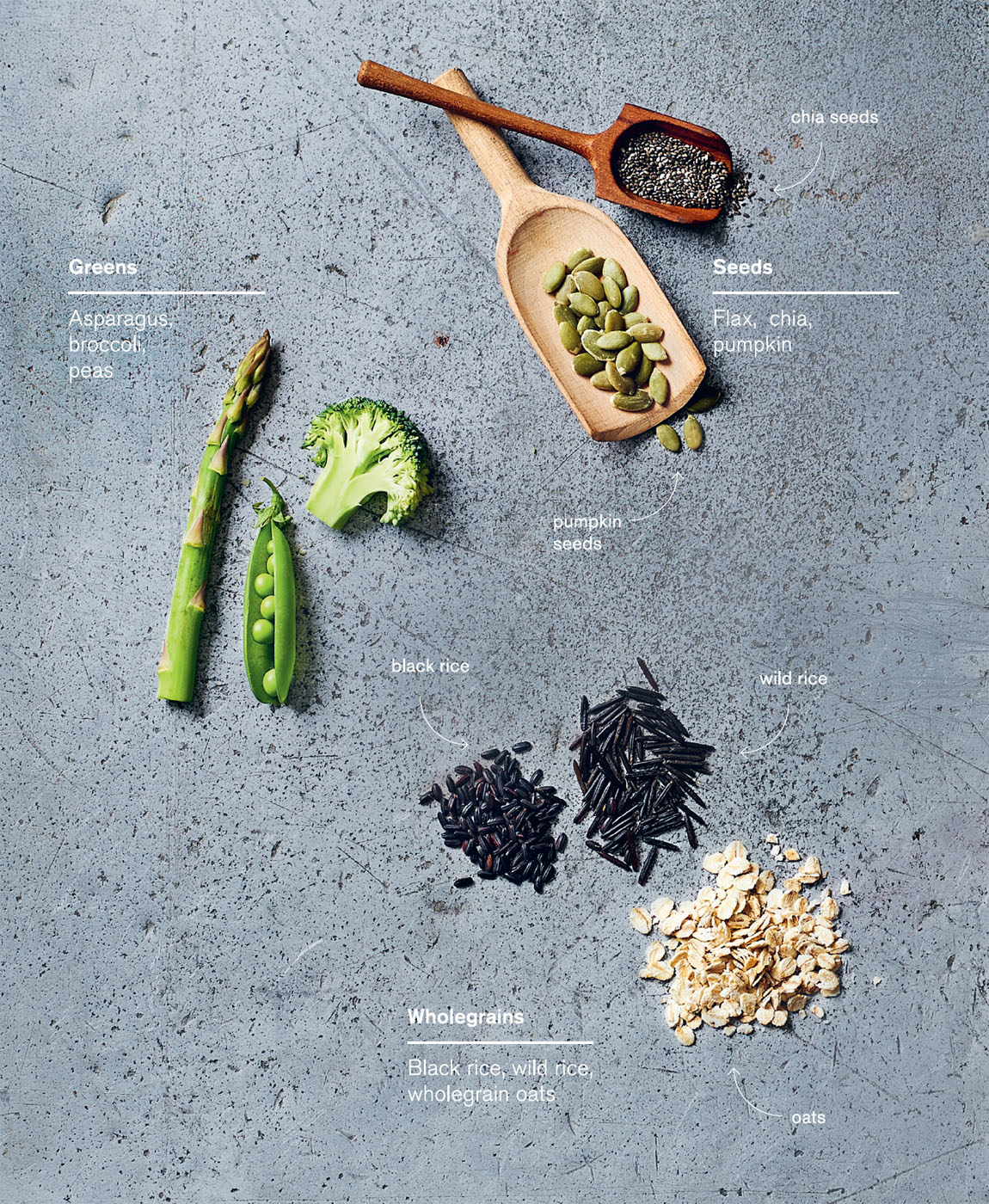

Food is information

Our culinary journey through food in medicine could not be complete without visiting the topic of how food and lifestyle affect the very foundations of our existence.
Genes, made up of DNA, are what we inherit from our parents. They are the molecular code for characteristics such as how we look, the likelihood that we will get a chronic disease and even our behavioural traits. They also regulate intricate processes in the body, such as how we deal with inflammation and remove cancer cells. Vitamins and minerals, as well as things such as sleep quality and stress, can all impact the factors that alter the expression of our genes for better, or worse, health.


